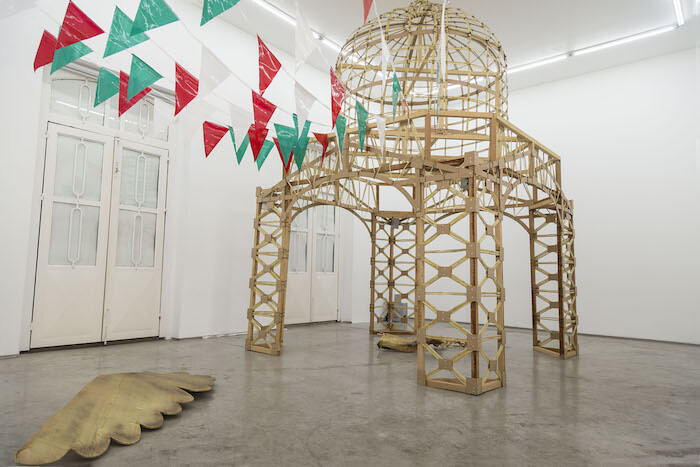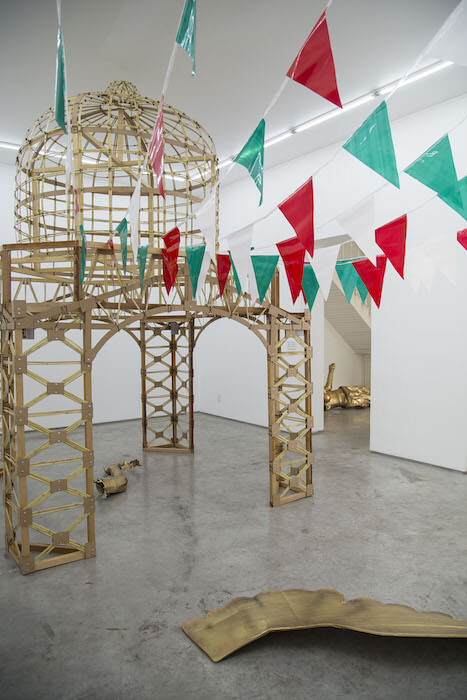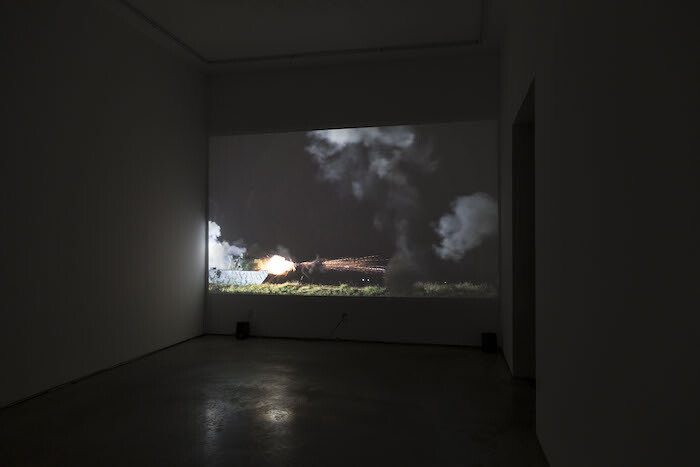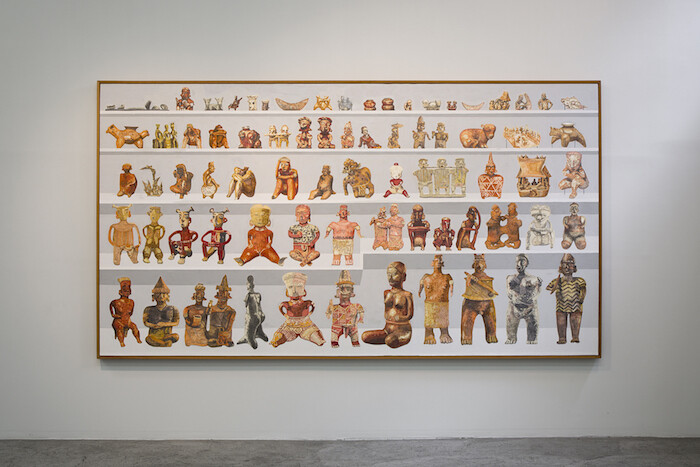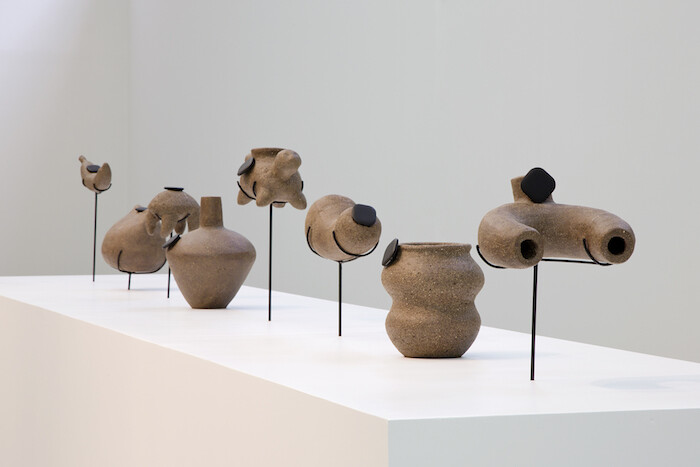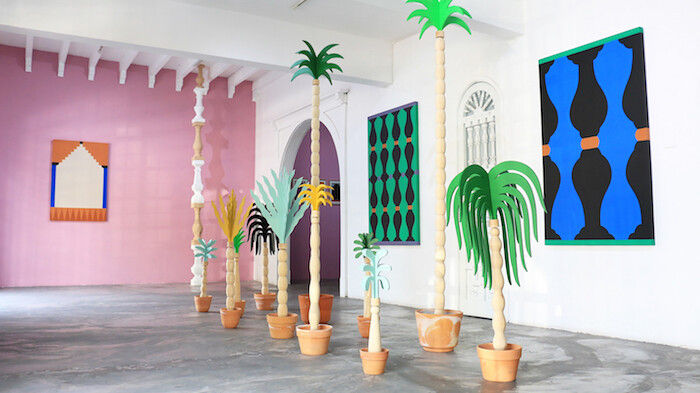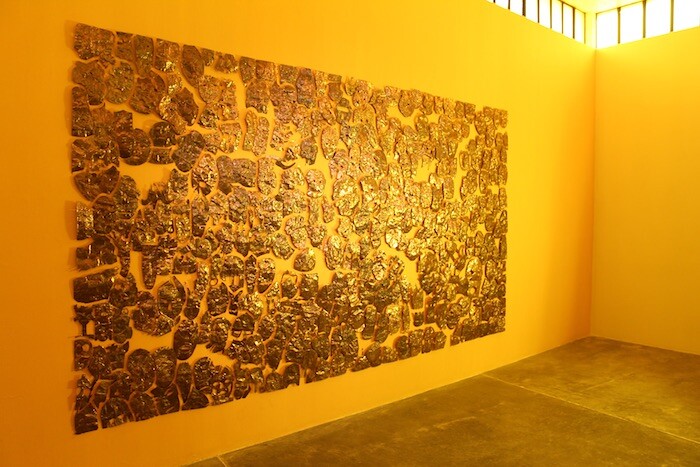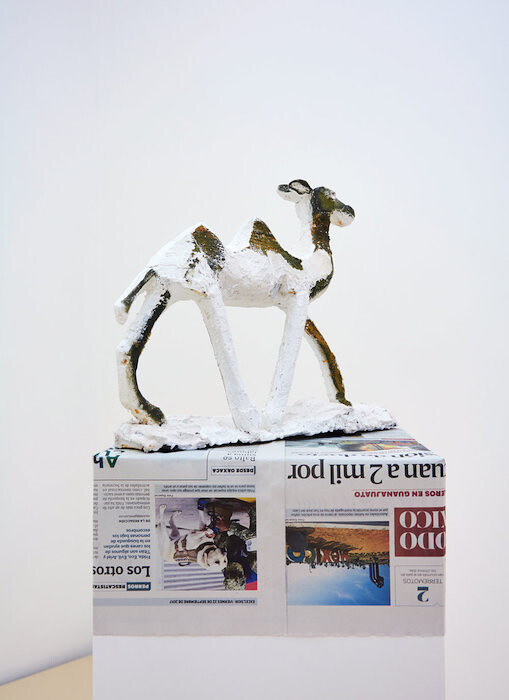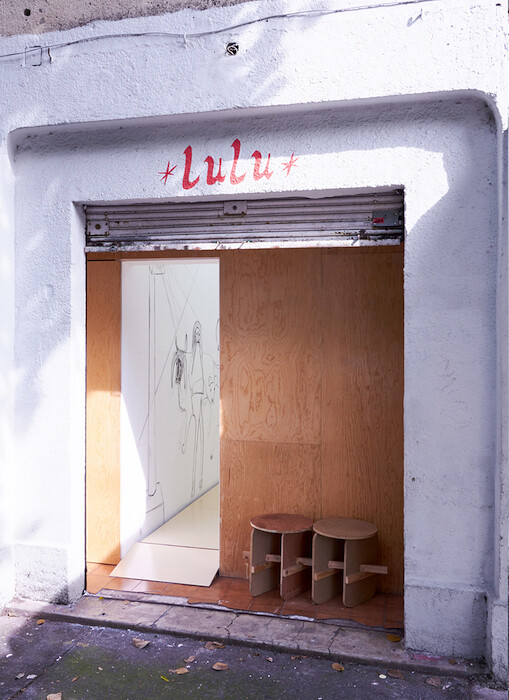On September 19, 2017, Mexico City was hit by one of the most destructive earthquakes in the country’s history. Gallery Weekend Mexico City was originally scheduled to open September 21, by which time everyone who could was out in the streets clearing rubble and handing out food and water. The participating galleries met to formulate a response—the first time that they had come together to coordinate anything. The gala opening was called off, and it was decided to reschedule the event for November 9-12. Gallery Weekend also opened up: before the quake, exhibitors had to buy their way in; afterwards, organizers freely distributed purple markers bearing the #GWCDMX hashtag to anyone who wanted to join in.
Spanning a room at Galeria Enrique Guerrero is Adela Goldbard’s El salón de los pasos perdidos (2017), an airy stick-and-cardboard scaffolding in the shape of one of Mexico City’s most overbuilt civic symbols—the Monumento a la Revolución. The four-sided triumphal arch, guarded at its corners by the towering socialist-realist figures of workers, mothers, and architects, is in fact the cupola of an unfinished palace, re-appropriated by the people when the money ran out. The first stone was laid on Independence Day, 1910, the same day that the Monumento a la Independencia was unveiled (a polished bronze angel topping a martial column) on September 16. In an adjoining gallery is Ángel caído (2017), a reed-and-paper version of el Ángel, broken to pieces, as the original version was in a July 1957 earthquake. By the following September 16, it had been restored. It’s as if there are no coincidences.
The 2017 earthquake came just two hours after the annual emergency drill that marks the anniversary of the 1985 disaster. In Goldbard’s version, speakers attached to the skeletal arches play a clattering recording of the scene at the Plaza de la República 32 years ago, when the tree-lined marble pavement around the Monumento a la Revolución became a relief center and refugee camp. In a loop of Goldbard’s videos, a tank burns in a field, a giant portrait bust is dumped into a river; faux monuments blow up and burn, in celebration and in effigy.
Like a paper Angel of History, the fifth edition of Gallery Weekend Mexico City looked backwards at the accumulated rubble of the past—though, as with any country that has cycled through several empires, not all was the result of seismic activity. A remarkable number of shows ventured an artistic sort of anthropology. In the savviest example, at Labor, the Columbian-born, L.A.-based artist Gala Porras-Kim’s exhibition “An Index and its Settings” presented pencil renderings of west-Mexican ceramic statuettes from a named collection at LACMA, filed not under artifacts but objets d’art. In a dramatic color drawing (78 west Mexico ceramics from the LACMA collection: Nayarit Index, 2017), a few dozen are indexed by scale—an obvious formal quality, cheekily divorced from any real knowledge about the objects’ origins or meanings. Another group of contemporary, clay-brown ceramics took the generic forms of ancient pieces—banana/boat, two-headed animal, seated human figure; each came with a GPS tracker attached with monofilament in order to, as the artist put it, locate the objects in time and space.
Porras-Kim wryly points out what others take for granted or even promote—a prevailing abstraction of historical forms. A more hapless show, “Trompe-l’oeil,” came courtesy of Celaya Brothers, where the Italian artist Agostino Iacurci spent several weeks translating the decorative qualities of the megalopolis into a series of graphic paintings of banisters, doorways, and posts (Balaustradas No. 3, 2017; Entrada muy pequ 3w No. 6, 2017; Planta 11, 2017). At Museo El Eco, Théo Mercier installed his site-specific Gold War Wall (2017), a mural comprising 300 battle masks recreated in brass from images in museum catalogs. For a concurrent solo presentation at Marso Gallery, Mercier folded the aesthetic of Mexico City’s cinderblocks and tiles into an already overflowing mixture of cultural citations: replica Olmec trinkets, “African” motifs, combined in plinthed-up, Brancusi-esque stacks. The show is called “Phantom Legacy”; the parquet floors covered in what the gallery’s press release describes as the debris from the exhibition space’s old walls and ceilings, but that looks like a fine-grained layer of cat litter.
Post-quake, any work with a trace of urbanism seemed suddenly, thoroughly kinetic. It was more than coincidence; it was thanks to an ancient obsession with “architecture, anthropology, and archaeology” that the September 19 earthquake presaged “Delirios urbanos” at Cuarto de Maquinas, a group show full of right angles, building materials, and artistically reimagined public space; or that, at Proyectos Monclova, a video by the German Michael Sailstorfer (Tränen, 2015) showed a red-tiled house being slowly demolished by wrecking balls the shape of tears; or that Galeria Hilario Galguera presented the Belgian sculptor Peter Buggenhout, whose twisted metal-and-plaster assemblages with titles like Mont Ventoux #16 (2015) and Mute Witness #2 (2017) resemble dusty, bloody John Chamberlains.
The colonias of Condesa and Roma, some of the hardest hit by the quake, also happen to be the densest gallery districts: an apartment building down the block from House of Gaga collapsed to its garage. Arróniz Arte Contemporáneo was structurally damaged, along with its owner’s upstairs apartment; for now they’ve mounted a show called “Temporal, referencias al espacio” [Temporary, references to space] in a friend’s empty restaurant. The bar is still stocked and visible behind the bare stud walls that support paintings and photos mostly by the gallery’s artists, invoking the lumber that will rebuild the shaken city.
An AV-heavy Melanie Smith show at Proyecto Paralelo was postponed to February; instead, the gallery went into its flat files and storage racks to produce one of the most direct responses to the temblor—an exhibition of chance operations. “Parajes de lo vago” [Paragraphs of the vague] featured collaged scores by Christian Marclay (Ephemera, 2009), a “Wet Paint” sign by Muntadas (Wet Paint, 2008); white minimalist blocks on the floor by Cynthia Gutiérrez (Soportando el abismo II, 2016) that read, of course, as rubble…
At Lulu, German-Iraqi artist Lin May Saeed was installing “Djamil” when the quake hit, and couldn’t get back into the space for a couple days. When the show resumed, she set Djamil sculpture (2017)—a Styrofoam and plaster maquette camel—on a plinth wrapped in that day’s newspaper which, when folded, happened to reveal a photo of Frida, Mexico’s most famous rescue dog.(1)
Is the generation too young to remember the 1985 quake defined by its apathy? Before the events of 2017, even the members of that generation suspected as much. But in the aftermath of an earthquake, life proved greater than art; and when it was time to return to work, there among the navel-gazing formalism was art that seemed not only to riff on the past, but to care about its impact on the present. In the aftermath of history, this is one more reason to hope.
(1) https://www.theguardian.com/world/2017/sep/23/frida-the-mexican-rescue-dog-who-has-saved-more-than-52-lives.

